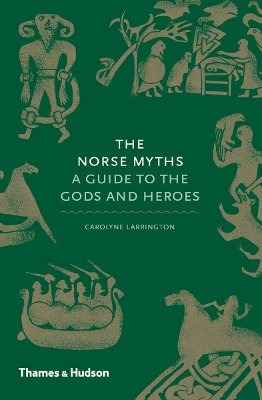
Who were the Norse gods – the mighty Æsyr, led by Óðinn, and the mysterious Vanir? In The Norse Myths we meet this passionate and squabbling pantheon, and learn of the mythological cosmos they inhabit. Passages translated from the Old Norse bring this legendary world to life, from the myths of creation to ragnarök, the prophesied end of the world at the hands of Loki’s army of monsters and giants, and everything that comes in between: the problematic relationship between the gods and the giants, in which enmity and trickery are punctuated by marriages and seductions; the (mis) adventures of human heroes and heroines, with their family feuds, revenges, marriages and murders; and the interaction between the gods and mortals, as Óðinn, the Allfather, betrays his human protégés in order to recruit (dead) heroes for his army. Carolyne Larrington describes the myths’ origins in pre-Christian Scandinavia and Iceland, and their survival in artefacts and written sources, from Old Norse sagas and poems to the less approving accounts of medieval Christian writers. She traces their influences into the work of Wagner, William Morris and J.R.R. Tolkien, and even the recent Game of Thrones in the resurrection of the Fimbulvetr, or ‘Mighty Winter’.
My first dip into Norse Mythology was Neil Gaiman's Norse Mythology, which, to my mind, was the perfect introduction. This book was an excellent next-step - a little bit more in-depth, a little more of an academic bent, without being dry or boring.
Larrington gets off to the best possible start by including, on the very first page, a pronunciation guide to Old Norse, covering the extra letters of 'eth (ð)' and 'thorn (þ)', as well as the various diphthongs, æ, ö and ø. I immediately bookmarked this page, because I referred back to it a lot. Having given the reader this guide, Larrington then proceeds to refer to the gods and heroes by their original Old Norse/Icelandic names/spellings, so Thor is þórr; Odin is Óðinn. This authenticity might annoy some readers, but I appreciated the exercise - hopefully some of it will stick now that I've used it for 200+ pages.
The layout of the chapters is as close to chronological order as is possible. Larrington uses the first chapter to discuss her main sources, and then goes on with the creation of the world, the order of the gods and giants, the heroes, ragnorök, and the rebirth of the world. Interspersed throughout are the myths that Gaiman's readers will recognise, as well as a fair few more, with a bit of commentary as to the historical background, modern day evidence, and a nod to the possible motivations and bias of Snorri Sturluson, the author of the Prose Edda, the earliest known written form of the Norse myths.
At only a little over 200 pages, this book is short on the commentary and long on the myths, so it's likely not aimed at someone with a-better-than-beginner knowledge of Norse mythology. There are also a generous number of illustrations and photographs (b/w) sprinkled throughout the text, showing images through the ages that illustrate the various myths.
All in all a delightful resource for me, and an engrossing way to while away a cold and windy afternoon snuggled up on the couch with the cats.
Reading updates
-
Started reading
-
2 June, 2019:
Finished reading
-
2 June, 2019:
Reviewed
